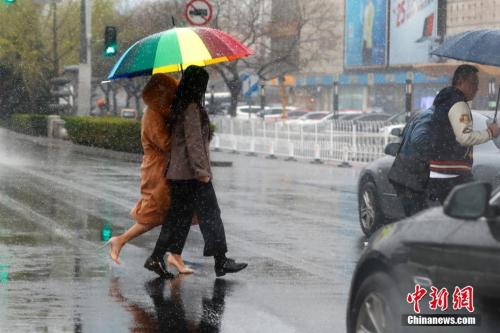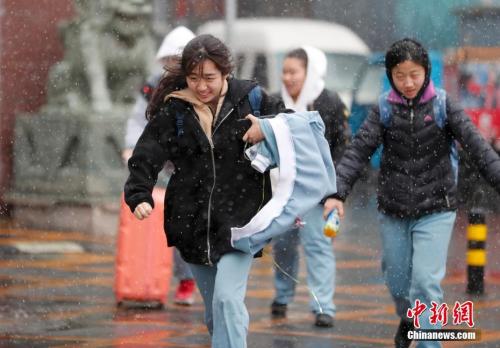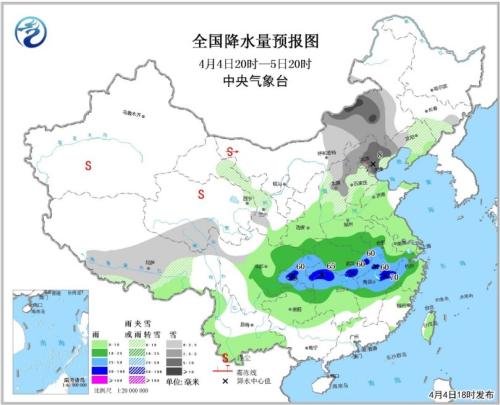Rain and snow in many places cool down to welcome the Qingming holiday. People feel the "four seasons" within a few days.
BEIJING, Beijing, April 5 (Xinhua) In the past few days, under the continuous influence of cold air, the temperature in many parts of the country plummeted, and people felt the "four seasons change" in just a few days. According to the weather forecast, the Qingming holiday will be opened in many parts of the country today in strong winds, sand blowing or rain and snow cooling.

China News Service reporter Futian photo
Short sleeves, long pants and down jackets … … People in many places feel the "four seasons" for several days.
"Spring bamboo shoots have been eaten, rape flowers have been seen, short sleeves have been worn, autumn trousers have been put on again, and down jackets have been put on today. Is it the Spring Festival soon? How time flies! "
In the past few days, this paragraph describing the changeable weather has been circulated on the Internet. Indeed, under the influence of continuous strong cold air, the temperature in many places in China has experienced a "roller coaster" change in just a few days.
Since the 3rd, under the influence of cold air, the highest temperature in some parts of the north has dropped by 8-14℃, and the local temperature has exceeded 20℃.
Just a few days ago, most parts of the country were still heating up rapidly, and the highest temperature in some areas even exceeded 30 C. According to the monitoring of the meteorological department, the average temperatures in March in Xinjiang, Inner Mongolia, Ningxia, Qinghai, Shanxi and Anhui were all the highest in the same period since 1961.
According to the latest forecast of the Central Meteorological Observatory, due to the influence of strong cold air, the gale and cooling weather from north to south will continue in most parts of the country from April 4 to 6.
It is estimated that from 20: 00 on the 4th to 20: 00 on the 6th, the temperature in the central and eastern parts of northwest China, central and western Inner Mongolia, eastern part of southwest China, south of the Yangtze River and southern China will drop by 6-10℃ successively from north to south, and the local temperature drop can reach more than 12℃. There are northerly winds of 4-6 in the north of the Yangtze River, and gusts in some areas can reach 7-8.
The strong wind also rolled up dust and affected most of the northwest, and sandstorms occurred in parts of western Inner Mongolia, Qaidam Basin in Qinghai and Nanjiang Basin in Xinjiang. At 18: 00 on the 4 th, the Central Meteorological Observatory continued to issue a blue warning of sandstorms.

China News Service reporter Du Yangshe
Blue Warning of Blizzard in Beijing Snowfall in April is not uncommon.
In addition to strong winds, dust and cooling, snowfall or sleet occurred in many places in North China on the 4th.
Meteorological monitoring showed that during the day on the 4th, rainfall, snow or sleet ranged from 2mm to 10mm in parts of central and western Beijing, south-central and northwestern Hebei, northwestern Shanxi and central Inner Mongolia, and the local area ranged from 10mm to 19mm. On the 4th, the Central Meteorological Observatory also continuously issued a blue warning of blizzard.
Taking Beijing as an example, the Beijing Meteorological Observatory issued a blue warning of snowstorm on the afternoon of the 4th, saying that moderate to heavy snow will occur in most parts of Beijing from the evening of the 4th to the night, and there will be heavy snow in parts of the west and north.
According to the report of China Weather Network, statistically speaking, this is not the latest snowfall in Beijing. According to the latest last snow day monitoring in the southern suburbs observatory, the latest last snow day in Beijing in history is April 21, 1959.
Meteorologists said that the snowfall in Beijing on April 4 ranked only the eighth night in history, and April snowfall was a normal weather phenomenon, which was not uncommon.
Fang Yi, chief forecaster of the Central Meteorological Observatory, said that the cause of this large-scale snowfall was mainly due to the warm and humid airflow encountered by the cyclone moving eastward and meeting with the cold air from the south on the east road, coupled with the low temperature after the strong wind cooled down, which formed a relatively obvious snowfall.

Expert: Severe cooling is not called "late spring cold" because of the high temperature in the early stage.
On the 5th, the Qingming small holiday opened. According to the forecast of the meteorological department, during the Qingming holiday, "cold" is still the main tone of the national meteorological map.
It is estimated that from 20: 00 on April 4 to 20: 00 on the 6 th, the temperature in the central and eastern parts of northwest China, central and western Inner Mongolia, eastern part of southwest China, south of the Yangtze River and southern China will drop by 6 ~ 10℃ from north to south, and the local temperature drop can reach more than 12℃. There are northerly winds of 4 ~ 6 in the north of the Yangtze River, and gusts in some areas can reach 7 ~ 8.
From the night of 4th to 5th, there will be heavy snow (5 ~ 8mm) in parts of central and northern Beijing, northeastern Hebei, northern Tianjin and central Inner Mongolia. The depth of newly added snow in the above areas is 1 cm to 3 cm, and the local area can reach 4 cm to 6 cm.
In the south, from the night of 4th to 6th, there will be a precipitation process in the area south of Huaihe River, with moderate to heavy rain in the eastern part of Southwest China, Jianghuai, Jianghan and north-central Jiangnan, and local heavy rain, accompanied by short-term heavy precipitation and strong convective weather such as thunderstorms and strong winds.
The meteorological department reminded that in the next few days, there will be many strong winds and rainy and snowy weather in the country. During holidays, the public should pay attention to falling objects and traffic safety. There are dusty weather in many places in the north, so it is necessary to take protective measures when going out.
In view of the sharp cooling caused by the current rain and snow process, Fang Yi analyzed that although the cooling was obvious, it was not a "cold spring".
He analyzed that the public believes that the current low temperature is due to the obvious warming up some time ago and the high temperature. "The temperature in North China and other places was above 6 C higher than that in the same period, so the cold air felt colder this time. In fact, the current temperature is only a little lower than normal, and the current temperature is also rising rapidly, which is far from ‘ Cold spring ’ 。” Fang said. (End)